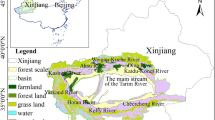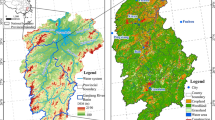Abstract
The three-river source region (TRSR, including Yangtze, Yellow and Lancang rivers), located in the Qinghai-Tibetan Plateau, China, is a typical alpine zone with apparent ecosystem vulnerability and sensitivity. In this paper, we introduced many interdisciplinary factors, such as landscape pattern indices (Shannon diversity index and Shannon evenness index) and extreme climate factors (number of extreme high temperature days, number of extreme low temperature days, and number of extreme precipitation days), to establish a new model for evaluating the spatial patterns of ecosystem vulnerability changes in the TRSR. The change intensity (CI) of ecosystem vulnerability was also analyzed. The results showed that the established evaluation model was effective and the ecosystem vulnerability in the whole study area was intensive. During the study period of 2001–2011, there was a slight degradation in the eco-environmental quality. The Yellow River source region had the best eco-environmental quality, while the Yangtze River source region had the worst one. In addition, the zones dominated by deserts were the most severely deteriorated areas and the eco-environmental quality of the zones occupied by evergreen coniferous forests showed a better change. Furthermore, the larger the change rates of the climate factors (accumulative temperature of ≥10°C and annual average precipitation) are, the more intensive the CI of ecosystem vulnerability is. This study would provide a scientific basis for the eco-environmental protection and restoration in the TRSR.
Similar content being viewed by others
References
Adriaenssens V, De Baets B, Goethals P L M, et al. 2004. Fuzzy rule-based models for decision support in ecosystem management. Science of the Total Environment, 319(1–3): 1–12.
Alewell C, Manderscheid B. 1998. Use of objective criteria for the assessment of biogeochemical ecosystem models. Ecological Modelling, 107(2–3): 213–224.
Bantayan N C, Bishop I D. 1998. Linking objective and subjective modelling for landuse decision-making. Landscape and Urban Planning, 43(1–3): 35–48.
Basso F, Bove E, Dumontet S, et al. 2000. Evaluating environmental sensitivity at the basin scale through the use of geographic information systems and remotely sensed data: an example covering the Agri basin (Southern Italy). Catena, 40(1): 19–35.
Beisner B E, Haydon D T, Cuddington K. 2003. Alternative stable states in ecology. Frontiers in Ecology and the Environment, 1(7): 376–382.
Boughton D A, Smith E R, O’Neill R V. 1999. Regional vulnerability: a conceptual framework. Ecosystem Health, 5(4): 312–322.
Chapin F S, Mcguire A D, Randerson J, et al. 2000. Arctic and boreal ecosystems of western North America as components of the climate system. Global Change Biology, 6(S1): 211–223.
Chmura D J, Anderson P D, Howe G T, et al. 2011. Forest responses to climate change in the northwestern United States: Ecophysiological foundations for adaptive management. Forest Ecology and Management, 261(7): 1121–1142.
Eisele M, Steinbrich A, Hidebrand A, et al. 2003. The significance of hydrological criteria for the assessment of the ecological quality in river basins. Physics and Chemistry of the Earth, Parts A/B/C, 28(12–3): 529–536.
Folke C, Carpenter S, Walker B, et al. 2004. Regime shifts, resilience, and biodiversity in ecosystem management. Annual Review of Ecology, Evolution, and Systematics, 35(1): 557–581.
Fu X F, Yang S T, Liu C M. 2007. Changes of NDVI and their relations with principal climatic factors in the Yarlung Zangbo River Basin. Geographical Research, 26(1): 60–66. (in Chinese)
Goda T, Matsuoka Y. 1986. Synthesis and analysis of a comprehensive lake model-with the evaluation of diversity of ecosystems. Ecological Modelling, 31(1–3): 11–32.
Goetz S J, Bunn A G, Fiske G J, et al. 2005. Satellite-observed photosynthetic trends across boreal North America associated with climate and fire disturbance. Proceedings of the National Academies of Sciences of the United States of America, 102(38): 13521–13525.
Guo Z R, Jing E C, Nie Z L, et al. 2002. Analysis on the characteristics of soil moisture transfer during freezing and thawing period. Advances in Water Science, 13(3): 298–302. (in Chinese)
Hao Y H, Zhou H C. 2002. A grey assessment model of regional eco-environment quality and its application. Environmental Engineering, 20(4): 66–68. (in Chinese)
IPCC. 2007. Climate Chang. 2007. The Physical Science Basis. Contribution of Working Group I to the Fourth Assessment Report of the Intergovernmental Panel on Climate Change. Cambridge: Cambridge University Press.
Isidori M, Lavorgna M, Nardelli A, et al. 2004. Integrated environmental assessment of Volturno River in South Italy. Science of the Total Environment, 327(1–3): 123–134.
Kang S C, Xu Y W, You Q L, et al. 2010. Review of climate and cryospheric change in the Tibetan Plateau. Environmental Research Letters, 5(1): 015101, doi: 10.1088/1748-9326/5/1/015101.
Krivtsov V. 2004. Investigations of indirect relationships in ecology and environmental sciences: a review and the implications for comparative theoretical ecosystem analysis. Ecological Modelling, 174(1–3): 37–54.
Li A N, Wang A S, Liang S L, et al. 2006. Eco-environmental vulnerability evaluation in mountainous region using remote sensing and GIS: A case study in the upper reaches of Minjiang River, China. Ecological Modelling, 192(1–3): 175–187.
Li C L, Kang S C. 2006. Review of studies in climate change over the Tibetan Plateau. Acta Geographica Sinica, 61(3): 327–335. (in Chinese)
Li J L, Zhang W Y. 2011. A semiparametric threshold model for censored longitudinal data analysis. Journal of the American Statistical Association, 106(494): 685–696.
Linder M, Maroschek M, Netherer S, et al. 2010. Climate change impacts, adaptive capacity, and vulnerability of European forest ecosystems. Forest Ecology and Management, 259(4): 698–709.
Liu J Y, Xu X L, Shao Q Q. 2008. Grassland degradation in the “Three-River Headwaters” region, Qinghai Province. Journal of Geographical Sciences, 18(3): 259–273.
Liu L S, Zhang Y L, Bai W Q, et al. 2006. Characteristics of grassland degradation and driving forces in the source region of the Yellow River from 1985 t. 2000). Journal of Geographical Sciences, 16(2): 131–142.
Liu X D, Cheng Z G, Yan L B, et al. 2009. Elevation dependency of recent and future minimum surface air temperature trends in the Tibetan Plateau and its surroundings. Global and Planetary Change, 68(3): 164–174.
Ng K L, Obbard J P. 2005. Strategic environmental assessment in Hong Kong. Environment International, 31(4): 483–492.
Park Y S, Chon T S, Kwak I S, et al. 2004. Hierarchical community classification and assessment of aquatic ecosystems using artificial neural networks. Science of the Total Environment, 327(1–3): 105–122.
Popp J H, Hyatt D E, Hoag D. 2000. Modeling environmental condition with indices: a case study of sustainability and soil resources. Ecological Modelling, 130(1–3): 131–143.
Qian S, Fu Y, Pan F F. 2010. Climate change tendency and grassland vegetation response during the growth season in Three-River Source Region. Science China Earth Sciences, 53(10): 1506–1512.
Roerink G J, Menenti M, Soepboer W, et al. 2003. Assessment of climate impact on vegetation dynamics by using remote sensing. Physics and Chemistry of the Earth, Parts A/B/C, 28(1–3): 103–109.
Sun Y, Zhang W Y, Tong H. 2007. Estimation of the covariance matrix of random effects in longitudinal studies. The Annals of Statistics, 35(6): 2795–2814.
Suter G W. 1993. A critique of ecosystem health concepts and indexes. Environmental Toxicology and Chemistry, 12(9): 1533–1539.
Tran L T, Knight C G, O’Neill R V, et al. 2002. Fuzzy decision analysis for integrated environmental vulnerability assessment of the Mid-Atlantic region. Environmental Management, 29(6): 845–859.
Wang G X, Hu H C, Li T B. 2009. The influence of freeze-thaw cycles of active soil layer on surface runoff in a permafrost watershed. Journal of Hydrology, 375(3–3): 438–449.
Wang Z L, Fu Q, Jiang Q X, et al. 2011. Numerical simulation of water-heat coupled movements in seasonal frozen soil. Mathematical and Computer Modelling, 54(3–3): 970–975.
Westerling A L, Turner M G, Smithwick E A H, et al. 2011. Continued warming could transform Greater Yellowstone fire regimes by mid-21st century. Proceedings of the National Academy of Sciences of the United States of America, 108(32): 13165–13170.
Yang M X, Wang S L, Yao T D, et al. 2004. Desertification and its relationship with permafrost degradation in Qinghai-Xizang (Tibet) plateau. Cold Regions Science and Technology, 39(1): 47–53.
Zhang J G, Liu S Z, Yang S Q. 2007. The classification and assessment of freeze-thaw erosion in Tibet. Journal of Geographical Sciences, 17(2): 165–174.
Zhang Z Q, Wu Q B. 2012. Predicting changes of active layer thickness on the Qinghai-Tibet Plateau as climate warming. Journal of Glaciology and Geocryology, 34(3): 505–511. (in Chinese)
Zhou D W, Fan G Z, Huang R H, et al. 2007. Interannual variability of the normalized difference vegetation index on the Tibetan Plateau and its relationship with climate change. Advances in Atmospheric Sciences, 24(3): 474–484.
Author information
Authors and Affiliations
Corresponding author
Rights and permissions
About this article
Cite this article
Guo, B., Zhou, Y., Zhu, J. et al. Spatial patterns of ecosystem vulnerability changes during 2001–2011 in the three-river source region of the Qinghai-Tibetan Plateau, China. J. Arid Land 8, 23–35 (2016). https://doi.org/10.1007/s40333-015-0055-7
Received:
Revised:
Accepted:
Published:
Issue Date:
DOI: https://doi.org/10.1007/s40333-015-0055-7




